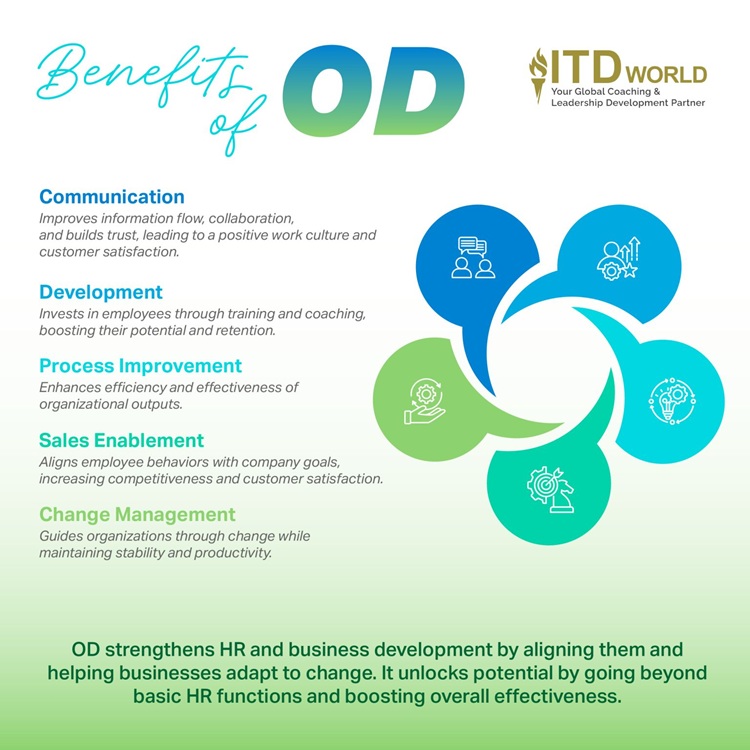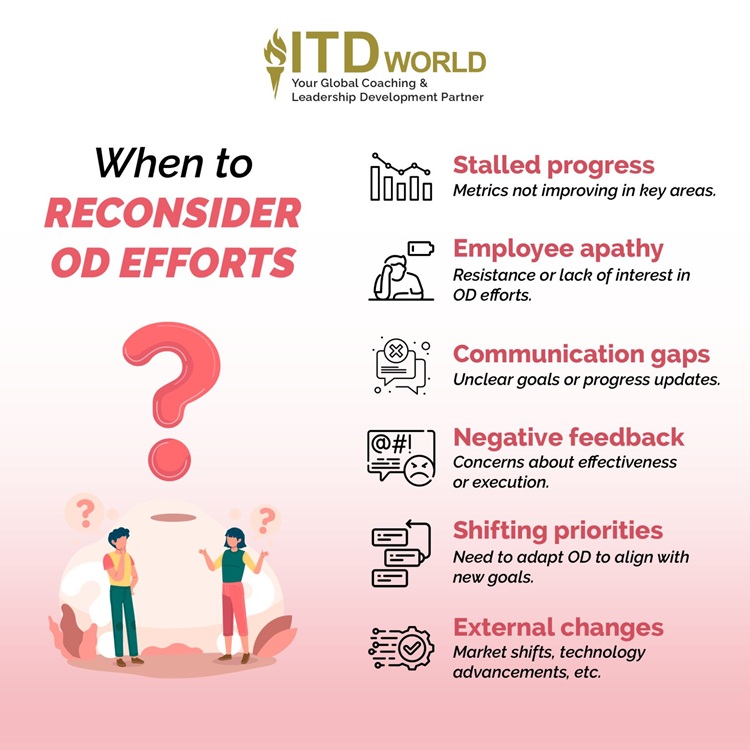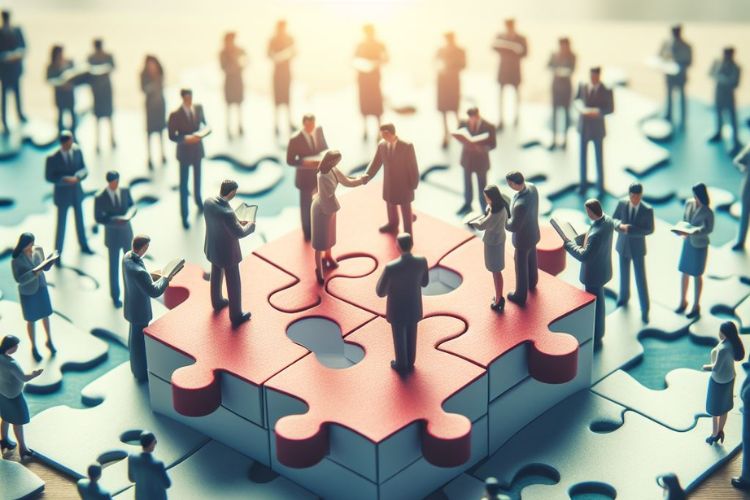Organization development (OD) is not merely about instituting change; it’s about fostering sustainable practices that fuel continuous growth. From cultivating a thriving workplace culture to implementing robust learning frameworks, discover how sustainable OD approaches can elevate your organization to new heights.
|
Author: Jonathan M. Pham |
Highlights
- Organization Development (OD) is a dynamic, research-driven, and systematic approach aimed at enhancing an organization’s effectiveness by strategically aligning its strategy, structure, people, and processes with its goals and external environment. Its primary goals are to boost productivity, improve decision-making, meet strategic objectives, and foster a culture of innovation and learning.
- OD utilizes diverse interventions, generally categorized into human process (e.g., team building, sensitivity training), techno-structural (e.g., organizational redesign, job enrichment), human resource management (e.g., performance appraisal, career planning), and strategic change (e.g., culture change, visioning). The process involves five major stages: Entering & Contracting, Diagnosing, Feedback & Analysis, Planning & Implementing, and Evaluating & Institutionalizing.
- While often housed under the Human Resources (HR) umbrella, OD has a distinct, broader, and more strategic focus on the overall organization (culture, structure, change management) compared to HR’s focus on the individual employee lifecycle (recruitment, compensation, compliance). OD supports HR by helping to design and implement effective talent management and change initiatives.
- OD is crucial for organizational agility and resilience in a constantly changing world, helping to unlock the full potential of individuals and teams. Key challenges include overcoming resistance to change, securing leadership commitment, ensuring adequate communication and training, and accurately measuring and evaluating the impact of interventions.
What is Organization Development?
Organizational development (OD) is a dynamic and research-driven approach that aims to enhance an organization’s effectiveness through the strategic alignment of its components. By integrating strategy, structure, people, and processes with the organizational goals and external environment, it serves as a systematic and collaborative method to diagnose and address organizational challenges while fostering positive change.
OD involves diverse activities and interventions to enable organizations to adapt to evolving conditions, stimulate innovation, and attain desired outcomes. Key components of the process include:
- Strategic planning: Ensuring coherence among organizational goals, strategies, and structures.
- Organizational design & Change management: Implementing effective structures, processes, and systems that support business goals. These include restructuring teams, altering reporting lines, and adopting innovative technologies.
- Leadership development: Equipping leaders with the skills and knowledge essential for effectiveness in a dynamic environment. This is achievable via training in areas such as coaching, communication, and conflict resolution.
- Talent management: Attracting, developing, and retaining top talent through initiatives like employee engagement programs, performance management, and succession planning.
- Culture change: Building up a positive and productive work environment where everyone feels valued and respected. Initiatives to enhance communication, collaboration, and trust make up an integral part of this transformative process.
- Learning & Development (L&D): Ensuring that team members are provided with growth opportunities – by orchestrating employee training programs, coaching, and mentoring opportunities.
- Consulting & Diagnosis: Utilizing various methods like interviews, surveys, and data analysis to identify organizational challenges and improvement opportunities.
- Designing & implementing interventions: Based on their diagnosis, OD professionals design and implement interventions ranging from training programs to structural changes.
- Facilitating change: OD practitioners play a crucial role in facilitating change within organizations, managing resistance, building consensus, and ensuring a smooth and successful change process.
- Evaluating & measuring results: Tracking the progress and impact of initiatives – making sure that they result in a positive contribution to the organization’s development.
In essence, OD professionals act as architects of change, who enable organizations to navigate challenges, enhance performance, and cultivate a positive and productive work environment.
Goals of Organization Development
Organization Development (OD) is driven by a comprehensive set of goals that collectively contribute to the enhancement of an organization’s effectiveness. These objectives, as outlined by the Society for Human Resource Management (SHRM), revolve around two main pillars – Organizational structure & People development:
- Boosting productivity and efficiency
A fundamental goal of OD is the elevation of productivity and efficiency. This involves the systematic streamlining of processes, optimization of workflows, and elimination of obstacles that can impede progress. By enhancing output and optimizing resource utilization, organizations are equipped to achieve a higher level of operational efficiency.
- Improving decision-making
OD strives to foster an environment that encourages open communication, embraces data-driven approaches, and values diverse perspectives. This commitment leads to better-informed choices and elevates the success rates of organizational decisions.
- Meeting strategic objectives
The alignment of organizational strategies, structures, people, and processes to meet strategic objectives is a core aim of OD. It emphasizes the seamless integration of these elements to ensure that they collectively contribute towards achieving desired outcomes. This goal underscores the importance of a holistic and coordinated approach to organizational development.
- Developing people and culture
OD seeks to create a positive and supportive work environment where every member feels valued and engaged. Building trust, improving communication, and fostering collaboration is integral to cultivating a sense of community and strengthening organizational bonds.
- Promoting innovation and creativity
By fostering an environment that encourages experimentation, risk-taking, and out-of-the-box thinking, OD aims to stimulate groundbreaking ideas and solutions. This emphasis on creativity contributes to the organization’s ability to adapt to changing circumstances.
- Investing in talent development
OD recognizes the significance of providing employees with opportunities for growth and development, ensuring they possess the skills and knowledge needed to excel in their roles. This proactive approach contributes to building a skilled and motivated workforce.
- Driving positive change
Acknowledging the dynamic nature of the world, OD assists organizations in embracing and navigating change successfully. This could involve implementing new technologies, restructuring teams, or adapting to evolving market conditions.
- Embracing adaptability and agility
The world is constantly changing, and businesses are required to adapt accordingly. By equipping organizations to respond effectively to both internal and external changes, OD ensures their competitiveness and relevance in dynamic environments – which is crucial for sustained success in a rapidly evolving business landscape.
Read more: Agility Coaching – Navigating Change & Fueling Business Success
- Promoting learning
By fostering a culture of learning and development, OD encourages organizations to engage in ongoing refinement of processes, practices, and strategies. This commitment to continuous improvement positions organizations for long-term success and resilience in the face of evolving challenges.
Importance of OD in HR Management & Business Development
An organization, no matter how well designed, is only as good as the people who live and work in it.
Dee Hock
Organization development (OD) isn’t just a fancy term – it’s a powerhouse force that has the power to dramatically impact HR management and business development. Here’s why:
- HR & Business Development are intertwined
OD serves as the bridge connecting these two critical facets of an organization. It recognizes the symbiotic relationship between engaged, satisfied employees and positive business outcomes. By aligning HR practices and development initiatives with overarching goals, OD ensures a harmonious synergy that propels the organization forward.
- Change is inevitable
Markets evolve, technologies advance, and customer needs shift. OD stands as the guardian of organizational agility and resilience, equipping businesses to not only adapt but thrive amidst dynamic shifts. Its significance lies in preparing organizations for the challenges of an ever-changing landscape.
- Unlocking potential
A distinctive aspect of OD lies in its ability to unleash the full potential of individuals, teams, and the organization as a whole. Going beyond the realm of basic HR functions, the process functions as a catalyst for revealing latent capabilities, fostering innovation, and maximizing overall effectiveness.

Organization Development Functions & Benefits
- Communication: Communication stands out as a critical function of OD, enhancing collaboration and cooperation among team members and stakeholders. By improving information flow, feedback mechanisms, and trust both internally and externally, OD contributes to heightened customer satisfaction and loyalty – making it a linchpin for creating a positive and transparent culture.
- Development: Through methods such as training, coaching, mentoring, and feedback, OD elevates employee potential, contribution, and retention. This investment in human capital is one of the main driving forces behind organizational success.
- Process & service improvement: Through strategic interventions, OD stimulates positive and productive improvements, elevating the quality, efficiency, and effectiveness of organizational outputs and outcomes.
- Sales enablement: Sales enablement is an additional benefit of OD, aligning individual behaviors with the company’s strategy, objectives, and values. By promoting these values throughout the workplace and among customers, OD enhances competitiveness, adaptability, and customer satisfaction, ultimately contributing to the organization’s bottom line.
- Change management: Whether implementing new technologies, restructuring teams, or adapting to shifting market demands, OD becomes the guiding force that steers organizations through change while maintaining stability and productivity.

Organization Development vs HR
Where does Organizational Development (OD) belong? The placement of an OD department within an organization can be quite diverse, as there’s no one-size-fits-all approach.
In larger organizations, OD might exist as a separate department with its own team of specialists. This setup allows for focused attention on strategic change initiatives and long-term development goals. In most cases, though, OD falls under the umbrella of Human Resources (HR) – due to the overlap in areas like talent management and culture development. Sometimes, businesses may choose to bring in external OD consultants for specific projects or ongoing support.
While both OD and HR are integral to organizational success, they operate with distinct focuses, approaches, and skill sets.
- Focus
In terms of focus, OD takes a broader perspective, encompassing the overall effectiveness and well-being of the organization. This includes aspects such as culture, structure, and change management. On the other hand, HR primarily concentrates on managing the individual employee lifecycle, involving recruitment, performance management, compensation, and benefits.
- Approach
Regarding approach, OD adopts a strategic, systemic, and data-driven methodology, concentrating on long-term interventions and organizational transformation. In contrast, HR follows an operational, process-driven, and compliance-oriented approach, with a focus on day-to-day HR processes and employee relations.
- Skill sets
OD requires expertise in change management, facilitation, strategic planning, data analysis, and organizational design. HR, on the other hand, relies on skills in recruitment, training, performance management, employee relations, and compliance.
| Organizational Development (OD) |
Human Resources (HR)
|
|
| Focus | Broader focus on the overall effectiveness and well-being of the organization, including culture, structure, and change management |
Primarily focused on managing the individual employee lifecycle, including recruitment, performance management, compensation, and benefits
|
| Approach | Strategic, systemic, and data-driven. Focusing on long-term interventions and organizational transformation. |
Operational, process-driven, and compliance-oriented.
Dealing with day-to-day HR processes and employee relations. |
| Skills | Change management, facilitation, strategic planning, data analysis, and organizational design |
Recruitment, training, performance management, employee relations, and compliance
|
Despite these distinctions, OD plays a crucial supporting role in HR management. The former contributes to the latter by assisting in the design and implementation of effective talent management programs, performance management systems, and L&D initiatives. It also lends its expertise to facilitating change initiatives and guiding HR through organizational change efforts such as mergers, restructuring, or technology implementations.
Moreover, OD contributes to building a positive work environment, helping HR create a culture of trust, collaboration, and open communication. This, in turn, leads to increased employee engagement and satisfaction.
To maximize impact, effective collaboration between HR and OD is essential. This is achievable via:
- Clear communication: Establishing open channels to ensure both departments understand each other’s roles and priorities.
- Shared goals: Identifying common objectives that the two may work towards collaboratively.
- Joint initiatives: Promoting initiatives that leverage the strengths of both departments, such as training programs on change management or culture-building exercises.
- Mutual respect: Fostering a culture of mutual respect and appreciation for the unique contributions of each function.
History of Organization Development Theory
The history of organization development (OD) can be traced back to the early 20th century, but its formalization as a field began in the mid-1940s. Here’s a brief timeline of key events and figures:
- Hawthorne Studies (1920s-1930s): Researchers at the Hawthorne plant of the Western Electric Company conducted groundbreaking experiments that examined the impact of physical and social factors on worker productivity and motivation. This marked a pivotal moment, revealing the profound influence of human relations, group dynamics, and social norms on organizational behavior.
- Kurt Lewin’s Action Research (1940s-1950s): Social psychologist Kurt Lewin introduced the concept of action research, a cyclical process for solving real-world problems through planning, acting, observing, and reflecting. Lewin’s three-stage model of change – unfreezing, moving, and refreezing the status quo – became a foundational framework for organizational change.
- T-Group and Sensitivity Training (1950s-1960s): In the 1950s and 1960s, the National Training Laboratories (NTL) developed the T-group method, also known as sensitivity training. This approach, conducted in small group settings, aimed to increase self-awareness and understanding of others through feedback and interpersonal interactions.
- Survey Feedback (Late 1950s-Early 1960s): The Institute for Social Research (ISR) at the University of Michigan introduced the survey feedback technique. The method involved collecting and analyzing data from organizational members, providing feedback to identify issues and uncover opportunities for improvement.
- Socio-Technical Systems (1960s-1970s): Researchers at the Tavistock Institute in London developed the socio-technical systems approach. This perspective viewed organizations as complex systems with interrelated social and technical components. The goal was to optimize the fit between these aspects for enhanced organizational performance and well-being.
- Organizational Culture (1980s-1990s): The 1980s and 1990s saw increased attention to organizational culture. Defined as shared values, beliefs, norms, and assumptions guiding member behavior, organizational culture became a focal point for OD. The aim was to create and maintain a positive and adaptive culture aligned with the organization’s vision and mission.
These days, OD has evolved into a dynamic field incorporating various theories, methods, and practices. Some of its key concepts include:
- Change management: Theories and methods for planning, implementing, and sustaining effective organizational change.
- Organizational design: Aligning an organization’s structure, systems, and processes with strategic goals and objectives.
- Leadership development: Equipping leaders with the skills to guide teams and navigate change effectively.
- Group dynamics: Understanding how groups function and interact to improve teamwork, communication, and collaboration.
- Culture and Climate: Analyzing and shaping organizational culture and workplace climate to enhance employee engagement, motivation, and satisfaction.
- Learning and Development: Fostering a culture of continuous learning and development for employee skill enhancement.
- Action research: Applying research methods to real-world organizational problems to inform interventions and evaluate effectiveness.
When to Reconsider OD Efforts
Recognizing when to reconsider Organizational Development (OD) efforts is essential for ensuring the effectiveness of initiatives. Here are some red flags to watch out for:
- Stagnant metrics: When key performance indicators (KPIs) related to employee engagement, productivity, or other targeted areas show no improvement or remain stagnant.
- Limited buy-in: Apathy or resistance among employees towards organizational initiatives is a clear signal that the current strategies may not be resonating.
- Flawed communication: Insufficient communication about business goals, methods, and progress can lead to confusion and resistance among employees.
- Negative feedback: Negative feedback from employees and stakeholders concerning the effectiveness or execution of the business activities should not be ignored.
- Changing priorities: Shifting organizational goals or priorities may render existing initiatives misaligned. A dynamic organization requires adaptable OD strategies to ensure that efforts remain synchronized with evolving objectives.
- External influences: These include factors such as unexpected market changes, technological advancements, or shifts in competitor behavior.

Organization Development Model & Framework
There are different types of OD models, depending on the purpose and perspective of the organization. Some of the common approaches are:
- Diagnostic
Purpose: Identify gaps, analyze issues, and pinpoint opportunities for improvement in the organization’s current state. Design and implement interventions to address the gaps and achieve the desired state.
Examples: 7-S Framework, Burke-Litwin Model, McKinsey 3 Horizons of Growth Model.
- Transformational
Purpose: Envision and execute radical changes in strategy, structure, culture, or processes, managing transitions and overcoming resistance.
Examples: Kotter’s 8-Step Model, ADKAR Model, Bridges’ Transition Model.
- Experimental
Purpose: Test and learn from new ideas, innovations, or solutions in a fast and iterative manner, enabling adaptation to changing environments and customer needs.
Examples: Lean Startup Model, Design Thinking model, Agile model.
Most of the time, OD professionals are encouraged to blend elements from different models to create a customized approach that aligns with the unique needs of their organization.

Types of Organization Development Interventions
Generally, OD initiatives can be categorized into 4 groups as follows:
-
Human process interventions
Objective: Focus on interpersonal relations, group dynamics, and organizational culture.
Examples:
- Sensitivity training: Enhances self-awareness and understanding of others’ feelings and behaviors through interpersonal interactions in small group settings.
- Team building: Strengthens cohesion, trust, and performance within work groups through activities fostering mutual support and goal-setting.
- Organizational confrontation meeting: Resolves conflicts and addresses opportunities for improvement through large-scale meetings involving representatives from all organizational levels.
-
Techno-structural interventions
Objective: Address structural and technological aspects, including organizational design and employee engagement.
Examples:
- Organizational redesign: Changes the formal structure, roles, and responsibilities to improve alignment with strategy, environment, and culture.
- Job enrichment: Enhances employee motivation and satisfaction by incorporating variety, autonomy, feedback, and growth opportunities into their roles.
- Work design: Improves the efficiency, effectiveness, and quality of tasks, processes, and systems performed by employees.
-
Human resource management interventions
Objective: Focus on managing human resources, including performance management, talent development, diversity, equity, inclusion, and well-being.
Examples:
- Performance appraisal: Evaluates employee and leader performance based on predefined criteria, providing feedback, recognition, and rewards.
- Career planning & development: Assists employees and leaders in planning and achieving career goals through assessment, counseling, coaching, and training.
- Employee wellness: Promotes the physical, mental, and emotional health and well-being of employees and leaders through various programs and policies.
-
Strategic change interventions
Objective: Address the strategic direction and vision of the organization, including mission, values, objectives, and innovation.
Examples:
- Visioning: Creates and communicates a clear and compelling vision of the desired future state of the organization, inspiring and guiding members and stakeholders.
- Culture change: Alters shared values, beliefs, norms, and assumptions to align with the organization’s vision, mission, and strategy.
- Innovation & Learning: Fosters the habit of innovation and learning, encouraging the generation, testing, and implementation of new ideas, solutions, and practices.
Read more: Coaching Culture – Blueprint for Organizational Growth
Organizational Development Process – 5 Major Stages
Organization development (OD) is a dynamic process, not a one-time event. To guide you through this journey, let’s break down the 5 major stages involved:
-
Entering & Contracting
Identifying the need for change, the organization establishes contact with an OD practitioner, who works collaboratively with them to define expectations, scope, objectives, and stakeholders to be involved.
-
Diagnosing
The OD practitioner and the organization systematically gather and analyze data on the latter’s current state, exploring strengths, weaknesses, opportunities, and threats. Utilizing methods like surveys, interviews, and data analysis, they pinpoint the root causes of organizational issues and gaps between the current and desired states.
-
Feedback & Analysis
Stakeholders are presented with clear and actionable results of the diagnosis, opening avenues for discussions to gain deeper insights. Based on the input received, the diagnosis is refined and adjusted to ensure a more accurate understanding of organizational challenges and opportunities.
-
Planning & Implementing
OD practitioners and the organization collaboratively design and execute interventions. Parameters like timelines, responsibilities, budgets, and evaluation methods are clearly defined for monitoring and adjustments later.
-
Evaluating & Institutionalizing
The outcomes of interventions on organizational performance and goals are assessed – after that, they are integrated into organizational systems, processes, and culture to sustain positive changes.
Read more: Training Needs Analysis (TNA) – From Insight to Impact

Example of Organization Development in Action – by Phases
Scenario: ABCTech, a once-leading software company, faces declining innovation and market share. Its employees feel siloed, communication is poor, and decision-making lacks agility. ABCTech recognizes the need for change and hires an OD practitioner.
Entering & Contracting: The OD practitioner meets with key stakeholders (CEO, executives, department heads) to understand their concerns and desired outcomes. A contract is formed defining the scope of the project (boosting innovation), target audiences (all employees), and expected timeframe (12 months).
Diagnosing: The OD practitioner conducts surveys, interviews, and focus groups to gather data on team dynamics, communication channels, and barriers to innovation. They analyze the data to identify root causes, such as:
- Information silos: Teams work in isolation, hindering cross-pollination of ideas.
- Lack of collaboration: Rigid hierarchical structures limit open communication and idea sharing.
- Fear of failure: A culture of blame discourages employees from taking risks and experimenting.
Feedback & Analysis: The OD practitioner presents the findings to stakeholders, highlighting both strengths (dedicated workforce, strong technical skills) and weaknesses. Discussions refine the diagnosis, revealing a deeper need for cultural change to foster a more collaborative and innovative environment.
Planning & Implementing: Collaborative workshops are designed to break down silos, promote cross-functional communication, and encourage innovative thinking. These include:
- Hackathons: Interdepartmental teams brainstorm and prototype new ideas in a time-bound environment.
- Idea jams: Open sessions where all employees can share ideas and receive constructive feedback.
- Peer-to-peer & team coaching: Senior employees mentor junior colleagues to share knowledge and encourage risk-taking.
Evaluating & Institutionalizing: Progress is monitored regularly through employee surveys, innovation metrics (number of new ideas, prototype development), and feedback from internal hackathons. Successful interventions are integrated into company culture:
- Rewarding collaboration: Performance evaluations include metrics measuring teamwork and cross-functional initiatives.
- Open communication channels: Regular all-hands meetings and anonymous feedback platforms encourage employee voice.
- Budget allocation for innovation: Dedicated funding supports experimental projects and employee-driven initiatives.
Outcomes: After a year, ABCTech sees a significant increase in employee engagement, idea generation, and successful product launches. Communication improves, silos dissolve, and a culture of innovation takes root. The company regains its competitive edge and secures its future in the rapidly evolving tech landscape.

Key Elements of Organization Development
Beyond the main stages, several key components are required for a successful OD process to come together:
- Active involvement of senior leaders: Senior leaders play a pivotal role by championing the change effort, allocating resources, and providing visible support for the entire OD process. Their active involvement ensures that the OD initiatives align with the overall strategic direction of the organization.
- Data-driven approach: Interventions should be based on findings from data analysis and best practices in OD, not just intuition or guesswork. Surveys, interviews, performance metrics, and other data sources provide a strong foundation for understanding the current state and informing intervention design.
- Consistent and transparent communication: Regular communication keeps stakeholders informed about OD goals, progress, and challenges. Establish channels for two-way communication – so as to foster trust, buy-in, and active participation in the change effort.
- Collaboration & ownership: People feel more invested and committed to the changes they helped create. As such, organizations need to make sure that stakeholders are involved in designing and implementing interventions – and that teams work together across departments and levels to ensure successful implementation and support.
- Flexibility & adaptability: The OD process should be flexible enough to adapt to unforeseen circumstances and emerging priorities. Regular feedback mechanisms enable adjustments to interventions and the overall approach based on real-time insights.
- Training: Employee training and support should be prioritized to ensure team members possess the knowledge and skills required for success in the new environment. Empowered individuals are better equipped to contribute effectively to the organization’s success, aligning with the overall OD goals.
- Sustainability: New practices and behaviors become integral to day-to-day operations, evolving into ingrained organizational habits. Ongoing monitoring ensures the long-term sustainability of achieved improvements, preventing regression to previous states.
Challenges to Organization Development
- Resistance to change: Employees may fear uncertainties associated with change, perceiving it as a threat to job security or comfort with the status quo. Overcoming such resistance requires transparent communication, direct addressing of concerns, involving team members in the process, and emphasizing the change’s individual and organizational benefits.
- Lack of leadership commitment: Without active involvement and commitment from the management, any strategy will then lack momentum and direction. Securing senior leadership buy-in involves communicating the importance of OD to organizational goals – and encouraging their active participation in driving the change forward.
- Inadequate communication and training: Poor communication results in confusion, misinformation, and resistance. On the other hand, inadequate training leaves employees without the necessary skills and knowledge to adapt to new processes or systems.
- Limited resources and budget: The implementation of OD initiatives often requires financial resources for consultants, training, technology, and other needs. Organizations may address such restraints by developing cost-effective plans, leveraging internal expertise, exploring external partnerships, and showcasing the potential ROI to secure funding.
- Organizational inertia and siloed structures: Established routines and compartmentalized departments often hinder collaboration and the adoption of new approaches. Breaking down silos involves encouraging cross-functional teams, promoting collaboration through joint initiatives, and fostering a culture of shared goals and ownership.
- Measuring & evaluating impact: Demonstrating the effectiveness of OD interventions, especially with intangible outcomes like employee engagement, is a challenge in itself. Setting clear and measurable goals, establishing baseline data, utilizing diverse measurement methods, and regularly evaluating progress are necessary to address this challenge.
- Maintaining momentum: Ensuring changes become ingrained in the organizational culture requires ongoing effort and reinforcement. To prevent regression, OD practitioners should find ways to celebrate successes, provide ongoing support/ coaching, integrate new practices into ongoing processes/ systems, and continuously monitor the progress.
Organization Development Principles & Best Practices
- Champion change through training: Research by ATD showed that change management training is one thing that OD initiatives often fall short of. As such, businesses should recognize the importance of empowering employees to navigate the increasing number of change initiatives successfully.
- Flexibility over one-size-fits-all: Diversity is an inevitable thing in any organization – and it is one that brings endless possibilities. Under all circumstances, businesses should aim to adopt tailored strategies based on specific needs and contexts. For instance, managers in a sales-oriented company may perform very well when it comes to interpersonal relationships – but lack organizational and long-term planning skills. In that case, OD initiatives should not focus too much on soft skill training.
- Adopt a top-up approach: One reason why many OD interventions fail is that organizations often deploy their strategies top-down. Instead, prioritize employee involvement in the process to avoid resentment and foster a sense of ownership. Ensure that changes are not imposed but rather integrated collaboratively, enhancing engagement and reducing resistance.
- Focus on leadership development & executive coaching: Gallup’s findings revealed that managers pose a significant influence on employee engagement (around 70%). As such, investing in executive coaching and leadership development is a crucial aspect of all OD initiatives – so as to prevent the impact of weak leaders and pave the way for long-term growth.
Read more: Train the Trainer Model – Investing in Excellence
The Future of Organization Development – Expected Trends
As organizations navigate the ever-evolving landscape of technology, globalization, and changing demographics, the future of organizational development (OD) is poised for exciting transformations. Here are some key trends we can expect to see:
- Learning in the flow of work: Learning and development will seamlessly integrate into daily work routines, fostering a culture of continuous improvement and innovation. The emphasis will shift from formal training programs to real-time learning experiences, enhancing relevance, effectiveness, and efficiency.
- Impact of AI on organizational learning: AI will be harnessed to personalize learning experiences, augmenting and automating certain OD tasks. The results are increased accessibility and scalability of learning initiatives, which free up human resources for strategic OD aspects.
- Collective sense-making: This trend involves facilitating and enabling the organizational members and stakeholders to co-create and share meaning and understanding of the complex and dynamic situations and issues that they face, and to co-design and implement solutions that address them. This may improve communication, collaboration, and cooperation within the organization – as well as foster a culture of trust, openness, and diversity.
- Focus on human-centric design: Prioritization of employee well-being, mental health, and overall experience will be expected to drive organizational success. As such, leaders will need to be equipped with skills in managing diverse teams, fostering empathy, and creating supportive work environments.
- Continuous development over one-off change: Organizations will shift from episodic change management to continuous development, fostering change readiness and learning. Embracing change as an ongoing and adaptive process is crucial to enhance organizational agility, resilience, and responsiveness.
- Facilitation in change implementation: In the near future, the role of OD practitioners will gradually transform into that of facilitators, who help empower team members to take ownership of change.
- Focus on Diversity, Equity, and Inclusion (DEI): DEI principles will soon be integrated across all OD aspects, promoting representation and inclusivity in leadership, talent development, and policies. Employees will need to undergo training to identify and address biases, fostering a workplace that celebrates diverse thoughts and experiences. On the other hand, organizations are called to focus on systemic changes to promote DEI, recognizing the need to change the system rather than individuals.
Read more: 10 Learning & Development Trends to Help Your Workforce Thrive
Organization Development Jobs & Career Path
The world of OD offers a diverse range of exciting opportunities. Here are some common OD job titles you might encounter:
- Organizational Development Specialist: Analyzing organizational needs, designing interventions, and assessing progress in enhancing performance and culture.
- Learning & Development Specialist: Crafting and delivering training programs, coaching individuals and teams, and overseeing employee development initiatives.
- Change Management Consultant: Guiding organizations through major changes, managing resistance, and ensuring successful implementation.
- Human Resources Generalist/Manager: Undertaking various HR functions with a focus on talent management, employee engagement, and organizational development initiatives.
- Leadership Development Consultant: Collaborating with leaders to enhance skills, while providing coaching on effective communication, delegation, and team building.
To start embarking on this career path, you will need to meet some eligibility requirements, such as:
- Education: A bachelor’s degree in relevant fields like psychology, sociology, business administration, human resources, or education. Some roles may require a master’s degree or certification in organizational development or related disciplines.
- Skills: Essential skills include communication, collaboration, problem-solving, analytical, project management, facilitation, and leadership skills. In addition, familiarity with organizational development theories, models, methods, and tools, with the ability to apply them in diverse contexts is also essential.
- Experience: You should be able to demonstrate experience in working with organizations, teams, or individuals – with a focus on facilitating change, learning, or development. Prior roles in related fields like human resources, training, consulting, or coaching, as well as volunteering or interning for organizations requiring OD support.
- Networking: Build a network with OD professionals through platforms such as social media, online forums, webinars, podcasts, or events. Engage with the experiences, insights, and advice of seasoned OD practitioners and consultants to continually expand your understanding of the field.
Sample job description for reference purposes
Organization Development Books
- The Fifth Discipline: The Art and Practice of the Learning Organization by Peter M. Senge. The book introduces the learning organization, emphasizing continual adaptation and innovation. Disciplines explored include systems thinking, personal mastery, mental models, shared vision, and team learning.
- Flawless Consulting: A Guide to Getting Your Expertise Used by Peter Block. A classic guide for consultants and OD practitioners seeking to enhance skills and effectiveness, it covers a wide array of topics, such as contracting, data collection, feedback, implementation, and evaluation.
- Organizational Culture and Leadership by Edgar H. Schein. Schein’s work explores the interplay between organizational culture, leadership, and their impact on performance. Within the book, readers are introduced to a framework for assessing and changing organizational culture, along with case studies from various organizations and industries.
- Reinventing Organizations: A Guide to Creating Organizations Inspired by the Next Stage of Human Consciousness by Frederic Laloux. Here, the author presents a model for organizations that are more human, purposeful, and adaptive. His publication draws insights from organizations embracing self-leadership, wholeness, and evolutionary purpose.
- Team of Teams: New Rules of Engagement for a Complex World by Gen. Stanley McChrystal, Tantum Collins, David Silverman, and Chris Fussell. The book chronicles the shift of a large military organization into an agile network of collaborative teams. It offers principles for applying the same adaptive approach to diverse organizations.
- Organization Development and Change by Edgar F Huse. A foundational text covering the theory and practice of OD and change management. Interventions explored in the book include human process, techno-structural, human resource management, and strategic change.
- Organization Development Fundamentals: Managing Strategic Change by Prof. William J. Rothwell. In his work, Dr. Rothwell concisely covers the basics of OD and change management – as well as analyzes modern challenges and trends, such as learning in the flow of work and technology’s impact on organizational learning.
- Practicing Organization Development: Leading Transformation and Change by William Rothwell. The book focuses on assessing strengths-based approaches like appreciative inquiry and emotionally intelligent leadership. Theoretical and practical perspectives are provided alongside real-world case studies.
Bonus – Additional resources:
- Organization Development Journal. A peer-reviewed journal providing in-depth discussions on OD and work psychology – published quarterly to provide readers with a consistent flow of research and insights.
- Organizational Development Network. One of the largest international associations for OD practitioners – where resources are available for members to stay connected, current, and impactful in their OD practice.
Read more: Organizational Development Quotes to Spark Change & Drive Momentum
Level Up Your Organization Development Efforts With ITD World’s Professional Certificates & Solutions
At ITD World, we offer a wide array of solutions for those seeking to up their OD game. Whether you’re a seasoned practitioner or just starting out, we are here to cater to diverse needs and aspirations.
One aspect that sets ITD apart is our commitment to partnering with industry-renowned experts – examples include Dr. William Rothwell, a global authority on OD and change management, and other luminaries shaping the field. Thus, you can be confident that our programs are grounded in the latest thinking and best practices.
Certificates for every need:
- Certificate in Talent, Competency, and Succession Management (CTCSM): This program equips you with the skills to design and implement talent management strategies that drive organizational success.
- Certified Talent Development & Learning Professional (CTLP): Hone your expertise in designing, developing, and delivering impactful learning and development programs.
- Certified Master of Leadership (CML): Take your leadership skills to the next level by mastering the art of inspiring, motivating, and guiding teams toward achieving ambitious goals.
Our offerings extend beyond certificates. We understand that every organization is unique, with specific needs and challenges. That’s why we also provide customized in-house solutions. Our team of experienced consultants will work closely with you to design and deliver training programs, coaching initiatives, and change management interventions that are tailor-made for your organization’s context.
Contact ITD World today for a FREE consultation!
Final Thoughts
As we conclude our exploration, remember that Organization development (OD) isn’t a static endeavor; it’s a dynamic commitment to fostering a culture of innovation, adaptability, and employee well-being. By embracing the above-mentioned sustainable practices, businesses should be equipped to better navigate change and thrive in the face of future challenges.
Other resources you might be interested in:
- HR Business Partner (HRBP): Bridging HR & Business for Remarkable Results
- Inspirational Leadership: Key Principles & Practices
- Training Quotes: Inspirational Words that Motivate Learning & Growth

